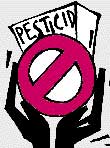My story today your story Tomorrow - Anil Agarwal (November 30, 1996) |
|||||||||||||||||||||||||||||||||||||||||||||||||||||||||
| Growing horde The Indian pesticide industry today has an installed capacity of 1,16,000 tonnes (t) per annum, of which about 70,000 t is in the organised sector, whereas the rest is in some 500-odd units belonging to the smallscale sector. It is doubtful that the smallscale sector has any appreciable control over contamination by pesticides. In 1994-95, India produced almost all the pesticides it consumed — some 83,000 t in the agricultural sector alone. Imports are currently about 2,000 t only. With liberalisation, controls on creating additional capacity for pesticide formulations has been lifted and there is no restrictions excepting six pesticides (aluminium phosphide, dimethoate, quinalphos, carbaryl, phorate and fenitrothion) for which licensing is compulsory. A Planning Commission study has projected pesticide consumption by 2000 ad at 1,18,000 t — 97,000 t for agriculture and 21,000 t for public health. It is interesting to note that most of the growth in the world pesticide industry is in developing nations. In value terms, growth in the pesticide industry between 1987 and 1993 in Latin America and Asia (outside Japan) was more than twice the global average.
Like the pesticides industry, the Indian paints industry
has also been growing rapidly. Between 1950 and 1982, production increased from 40,000 t
to 190,000 t (107,000 t in the organised sector and 83,000 t in the smallscale sector)
— the smallscale sector increased production eight-fold compared to the organised
sector’s slightly over three-fold increase. The smallscale sector is The MEF has no team working on the dangers posed by toxins like pesticides More questions My principal interest in writing this article is to inform the Indian people that they must not remain ignorant and nonchalant about the acute threats they face to their own health and to the health of their children. I find no concern in India about clean air, water or food, all of which are not just bacteriologically but also chemically contaminated today. At a seminar organised by a leading Delhi-based ngo on Delhi’s drinking water supply system in 1995, I had to point out that while there was so much talk about the inadequacy of water supply, there was almost none about its quality. What good is lots of water if it is so contaminated? Bacteriological contamination shows up in acute epidemics and hence, often leads to a hue and cry amongst the public and in the media. But chemical contamination takes years to show up in the form of cancers or hormonal and reproductive disorders, and hence unless there are good epidemiological studies carried out on a regular basis and a constant effort made by the medical profession and a vigilant media to inform the public about the health threats it faces, there will be no pressure whatsoever on the regulatory authorities to do anything to protect the environment. Ignorance is bliss for the the politician and the bureaucrat. Apart from the influence of industrial lobbies which may operate underhand, India’s overt governance systems themselves are incompetent. An excellent illustration of this is the fact that the ministry of environment and forests has no team working on the dangers posed by toxins like pesticides that permeate the environment and food systems. Summing up, I can only say that had not fate, friends and
well-wishers and committed scientists from various parts of the world not intervened to
help in my case, it would have been a Silent Spring for me in the prime of life. I can
only hope and wish that that no fellow citizen has to suffer the same fate. And that
Indian civil society can, one day, force our misguided |
|||||||||||||||||||||||||||||||||||||||||||||||||||||||||
 The Indian
government persists in allowing the production of a variety of deadly pesticides, even
after many of them have been banned or severely
The Indian
government persists in allowing the production of a variety of deadly pesticides, even
after many of them have been banned or severely